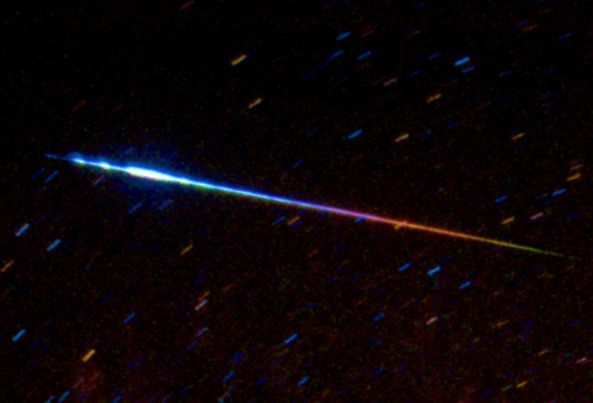
|
Credit & Copyright: S. Kohle & B. Koch,
Bonn University
Explanation:
The ongoing
Perseid
Meteor Shower should be at its strongest on August 12 and 13.
The best time to watch will be between 2:00 AM and dawn on Monday
morning (so plan on setting your alarm tonight!)
and then again on Tuesday.
In dark, moonless, predawn
skies you may see dozens of meteors per hour.
Grains of cosmic sand and gravel shed from
Comet Swift-Tuttle will
streak across the sky as they vaporize during entry into Earth's
atmosphere.
Tracing the meteor
trails backwards,
experienced skygazers will find they converge
on the constellation Perseus, thus this
annual meteor shower's name.
Pictured
above is a Perseid meteor from 1993.
The colors are representative but digitally enhanced.
As the
meteor streaked across the night sky,
different excited atoms emitted different colors of light.
The origin of the green tinge visible at the right is currently unknown,
however, and might result from
oxygen
in Earth's atmosphere.
|
January February March April May June July August September October November December |
| ||||||||||||||||||||||||||||||||||||||||||||||||
NASA Web Site Statements, Warnings, and Disclaimers
NASA Official: Jay Norris. Specific rights apply.
A service of: LHEA at NASA / GSFC
& Michigan Tech. U.
Based on Astronomy Picture
Of the Day
Publications with keywords: meteor - Perseids
Publications with words: meteor - Perseids
See also:
- APOD: 2025 August 25 B The Meteor and the Star Cluster
- APOD: 2025 August 21 B Mostly Perseids
- APOD: 2025 August 20 B Perseid Meteors from Durdle Door
- APOD: 2025 August 12 B Perseids from Perseus
- APOD: 2025 August 6 B Meteor before Galaxy
- APOD: 2025 August 3 B Milky Way and Exploding Meteor
- APOD: 2024 November 27 B The Meteor and the Comet
